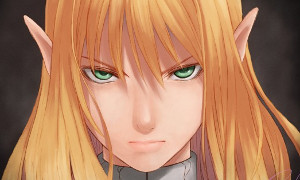 |
| Life in the forest is Black and White |
Somewhere in Vornheim, or while talking about Vornheim, Zak said that the encounter tables are for "days when something important happens" and this melds well with what wilderness encounter tables in AD&D are about. The chance of an encounter, BtB, increases in the wilderness not because there's more happening there, but because when something does happen it is more likely to be worth detailing.
While travelling across plains in the middle of a country, a party will typically have four or five days between encounters, meaning that a mounted party will probably go from point to point without any encounter at all. This doesn't mean that they see nothing and nobody on the way. Quite the opposite - they're probably meeting people all the time: innkeepers, farmers, hunters, other travellers and so on. But none of these are likely to do anything of note.
So, by the same token, things should only appear on the encounter tables if they have some potential to generate an "interesting" encounter.
 |
| "My road; my rules" Countryfile charity calander 2013 |
The answer has to be that when the party encounter "normal" animals, then there must be more to them than meets the eye. There is something "interesting" about them. This is, after all, a fantasy game not an episode of Springwatch.
One thing to remember is that all animals in AD&D can speak, if you have the right spell or have a 3rd level monk with the party (indeed, plants can speak too). So long as the animal's intelligence is not listed as "non-", any encounter may have some value just as a chance to look for clues when trailing someone or looking for some particular location. Speaking with animals, however, is restricted to normal real-world animals and technically does not include even the giant versions which come under the heading of monsters and so require speak with monsters instead.
And some animals have surprising levels of intelligence and even alignments - wolverines are semi-intelligent (not just "animal") and are evil; similarly with worgs and winter wolves. Dolphin are "very" intelligent and lawful good.
Also bear in mind that speak with animals has a pacifying effect on animals and their companions, so it can come in handy when facing, say, a bull elephant in a bad mood.
Morale is also important, as animals below "low" intelligence have a simple 50% morale score and will probably need to check this on a round-by-round basis, so prolonged combat with normal animals is very unlikely and even predators are unlikely to persist if they encounter serious resistance.
So, anyway, you've rolled a badger encounter. What's interesting about this badger? Here's 20 ideas (unless otherwise noted, 2-5 badgers of 1+2 HD are encountered as normal):
 |
| Frank Miller does Springwatch |
- One badger is a reincarnated NPC (d6: 1-3: druid; 4+ roll on table DMG p175) previous level: 1d6+6. Roll reaction as normal, but unable to speak common.
- Badgers are being ridden by (invisible) pixies. Roll the pixies' chance of in-lair (5%) to see if this is a patrol around their home. If not, they are looking for a party of evil adventurers they have heard about.
- A single badger with a gun (6 bullets, 1d8 per hit, treats all AC as 10 plus magic and dex, ranges: 2/4/6), leaning against a tree and smoking a cigarette. Very sweary and taciturn but can speak common. Motivation and history at DM's discretion but generally very bitter about something other than being a badger. If you don't like the gun, use a light crossbow instead.
- Badgers are sitting inside a circle of small standing stones (2' tall). They seem to be concentrating. The stones are a magical trap set up by a hunter.
- One badger leaps from a tree onto the head of one party member, while the rest attack in an attempt to drive the party away from their nearby sett. If spoken to, will say that a ranger taught them about ambushes.
- Tiny badger in a silver cage laying beside the path. Lost pet/victim of aristocratic child who passed here recently. If taken from the cage, the badger will return to full size and attack anyone nearby once before fleeing. The cage will similarly miniaturize anything which can be tempted into it (the top hinges back and is big enough for any animal smaller than a wolf or large dog). Magic resistance works against the cage at base chance. The cage is not very strong.
- Badgers are armed in platemail (AC 0) with small halbards (treat as two handed hand axes). They have been enchanted and equipped by a nearby hermit wizard (alignment: any non-good).
- Badgers are actually recently dead, animated, and have diseased bite. Treat as zombies for weapon effects, initiative etc. Only one attack, the bite for 1-3, but each bite is an exposure to a communicable disease as per DMG p13. All the badgers will have the same disease (% roll on p14) but roll occurrence and severity separately. A hag or annis lives nearby and is responsible for the state of the badgers.
- Badgers have rabies and are aggressive, attacking people and mounts. Treat as above but this is a natural disease and always affects the brain/nervous system with acute (one-off) occurrence and a base +4 on severity.
- The badgers have recently moved into area and are simply aggressively barring the party's route in an attempt to claim it as part of their new territory.
- Badgers have golden fur, only noticeable in the dark, which grants them +2 to AC (they detect as magical too). If obtained by a party this fur can be used to create a +2 shield (one pelt); +2 gnome-sized (2 pelts), dwarf-sized (3 pelts), elf-sized (4 pelts), or human-sized (6 pelts) "leather" armour. However, this armour will likewise glow in the dark and receives no bonus to saves against fire-based attacks. The badgers are sacred to the god Pan (or equivalent).
- The badgers attempt to join the party (by staying near to them and travelling in parallel). If communication is possible they will say that they are fleeing "a monster". If the party allows the badgers to remain with them, a hell-badger will attack everyone within 1d8 turns. This is a demonic giant badger, AC6, 6" move, HD 7, breath fire as hell hound (ie 7hp damage, 1" range), damage: 1-6/1-6/2-12, immunities as per demons, +1 or cold iron to hit, 30% magic resistance, 1hp/turn regeneration if not killed. If the giant is killed the badgers turn into humans from a distant land who explain they were cursed many years ago to assume animal shape and be pursued by the demon, taking a new shape each year. They are all princes in their distant home and can offer great reward if returned. They are 0-level.
- Five bipedal (normal sized) badgers materialize at some distance from the party (normal rules apply, including surprise). They are dressed in Arab-style clothing and carry scimitars and maces. Two are fighters (4th level), one is a cleric (also 4th), one a magic user (3rd level), and one a thief (6th level). They have an orb which has transported them here from their world where the level limits mean that they can not fight a tyrant they call "The Weasel" and its henchmamals; they have come to this world to seek aid. They are all NG. The orb translates for their leader and can transport any willing subject within 1", but will not activate for non-badgers.
- The badgers run up to the party and attempt to get their attention. If they can not open communication within five minutes, they run on. The badgers are brothers who have been polymorphed by a nearby witch who has likewise turned their sisters into swans. The brothers know that a party of hunters is in the area and that their sisters are in grave danger.
- The badgers are squaring up to a giant badger which has been transformed into a monster by drinking from a nearby pool in a ruined monastery. If the party attack the giant, the normal badgers will join in, otherwise the giant will attack the party anyway while the smaller ones escape.
- The badgers are encountered in a dip, clearing, coomb, or glade which also contains a 12' tall stone statue of a badger sitting up on its haunches. The eyes of the statue are overgrown with weeds but are sapphires of great size worth 2000gp each. The badgers will avoid the encounter but try to stay within 3" of the statue. If the statue is molested in any way, the badgers all become giant badgers and attack the intruders.
- The ground gives way beneath a mount or party member and angry badgers attack from the ruins of their sett. Any mount suffers 1d6 damage, and its rider must save Vs death or also take 1d6.
- The badgers are mounted on black bears and carry spears (treat as medium lances if they charge). Unless attacked, they simply watch the party pass from some high ground. Local legend speaks of the "striped knights".
- The badgers have collars studded with minor gems (mostly garnet; each badger has 3-6 red gems of base value 100gp. They are the escaped pets of a 7th level illusionist who is looking for them (10% chance per round of the illusionist arriving). He is very protective of the badgers and will reward their capture or avenge their loss as appropriate.
 The badgers are vampiric and each point of damage done by their bite (the 1-3 damage attack) restores them by the same amount (to a maximum of 10hp). Anyone killed by the badgers becomes a badger like them if the body is not buried in holy ground by the next full moon.
The badgers are vampiric and each point of damage done by their bite (the 1-3 damage attack) restores them by the same amount (to a maximum of 10hp). Anyone killed by the badgers becomes a badger like them if the body is not buried in holy ground by the next full moon.












